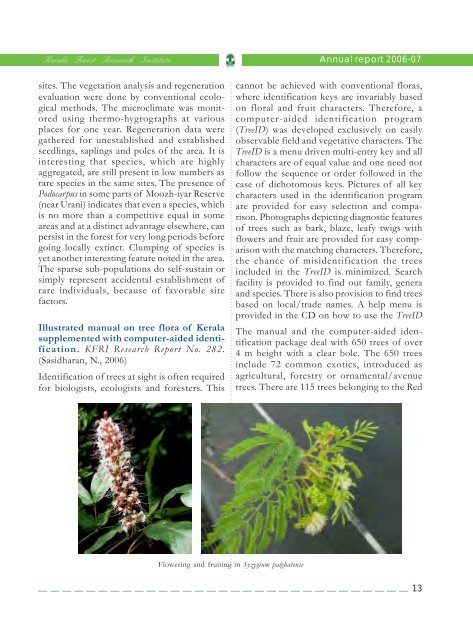Annual report <strong>2006</strong>-<strong>07</strong><strong>Kerala</strong> <strong>Forest</strong> <strong>Research</strong> <strong>Institute</strong>Biodiversity of plant pathogenic fungi inthe <strong>Kerala</strong> part of the Western Ghats. KFRI<strong>Research</strong> Report No. 280 (Mohanan, C., Sankaran,K.V. and Yesodharan, K., <strong>2006</strong>).An extensive survey on plant pathogenic fungiin the <strong>Kerala</strong> part of the Western Ghats carriedout during 2001-2004 revealed a rich fungalflora harboured in different forest ecosystems.Of the 4,101 fungal isolates obtained in thestudy, 60 pathogenic fungi were new species.A total of 151 pathogenic fungi were found tobe new records for the Western Ghats, while104 pathogenic fungi were reported for the firsttime from India. Altogether 639 plant speciesbelonging to 395 genera were found infectedwith pathogenic fungi. Of these, 175 plantspecies were found as new host records fordifferent pathogens.Among the different forest ecosystems studied,forest plantations supported a rich pathogenicfungal flora with plant-pathogenic fungal ratioas high as 1:14. In moist deciduous and semievergreenforests, the figures of plant-pathogenicfungal ratio were 1:3.1 and 1:3.48 respectively.Shola forests and wet evergreen forestsregistered comparatively low plant-pathogenicfungal ratio of 1:1.65 and 1:1.46 respectively.In forest nurseries, though a large number ofhost plants (154) were found diseased withfungal pathogens, the plant-pathogenic fungalratio was only 1: 3.77. Monoculture exoticplantations and disturbed natural standssupported a large number of fungal pathogens.Anthropogenic disturbances including forestfires seem to be the major contributing factorfor incidence and spread of fungal diseases andthereby build-up of pathogenic fungal populations.Biodiversity indices for plant pathogenic fungiin different forest ecosystems in the WesternGhats were worked out separately. Fungalspecies richness indices (Margalef ’s index andMenhinick’s index) ranged from 2.5605 to....................................................................................................................................................................................5.6652 and 4.0899 to 21.0853 respectively.Among the eight forest ecosystems studied,moist deciduous forests exhibited the highestspecies richness of fungi. Fungal speciesdiversity indices (Simpson’s index and Shannon’sindex) were deduced for each forest ecosystem,which ranged from 0.0228 to 0.1183 and1.1026 to 2.4482 respectively.With regard to the community structure andspecies composition, almost same fungal florawas observed in moist deciduous, semi-evergreenforests, and forest plantations; however,fungal species dominance and abundancereflected the environmental condi-tions, levelof disturbances, as well as host plant status.Evaluation of plant diversity in unloggedand logged forest stands of varying intensities.KFRI <strong>Research</strong> Report No. 281 (Menon,A.R.R. and Balasubramanyan, K., <strong>2006</strong>).The effect of logging on plant diversity andregeneration was studied in three tropical forestsites in <strong>Kerala</strong>. The sites were at Goodrikal RFin Ranni <strong>Forest</strong> Division in southern <strong>Kerala</strong>,Sholayar RF in Vazhachal <strong>Forest</strong> Division incentral <strong>Kerala</strong> and Kottiyoor RF in Kannur<strong>Forest</strong> Division in northern <strong>Kerala</strong>. Statisticallydesigned plots were laid out in unlogged andlogged forests of different types in all the threeView of study area in Ranni <strong>Forest</strong> Division12
<strong>Kerala</strong> <strong>Forest</strong> <strong>Research</strong> <strong>Institute</strong>Annual report <strong>2006</strong>-<strong>07</strong>sites. The vegetation analysis and regenerationevaluation were done by conventional ecologicalmethods. The microclimate was monitoredusing thermo-hygrographs at variousplaces for one year. Regeneration data weregathered for unestablished and establishedseedlings, saplings and poles of the area. It isinteresting that species, which are highlyaggregated, are still present in low numbers asrare species in the same sites. The presence ofPodocarpus in some parts of Moozh-iyar Reserve(near Urani) indicates that even a species, whichis no more than a competitive equal in someareas and at a distinct advantage elsewhere, canpersist in the forest for very long periods beforegoing locally extinct. Clumping of species isyet another interesting feature noted in the area.The sparse sub-populations do self-sustain orsimply represent accidental establishment ofrare individuals, because of favorable sitefactors....................................................................................................................................................................................Illustrated manual on tree flora of <strong>Kerala</strong>supplemented with computer-aided identification.KFRI <strong>Research</strong> Report No. 282.(Sasidharan, N., <strong>2006</strong>)Identification of trees at sight is often requiredfor biologists, ecologists and foresters. ThisFlowering and fruiting in Syzygium palghatensecannot be achieved with conventional floras,where identification keys are invariably basedon floral and fruit characters. Therefore, acomputer-aided identification program(TreeID) was developed exclusively on easilyobservable field and vegetative characters. TheTreeID is a menu driven multi-entry key and allcharacters are of equal value and one need notfollow the sequence or order followed in thecase of dichotomous keys. Pictures of all keycharacters used in the identification programare provided for easy selection and comparison.Photographs depicting diagnostic featuresof trees such as bark, blaze, leafy twigs withflowers and fruit are provided for easy comparisonwith the matching characters. Therefore,the chance of misidentification the treesincluded in the TreeID is minimized. Searchfacility is provided to find out family, generaand species. There is also provision to find treesbased on local/trade names. A help menu isprovided in the CD on how to use the TreeIDThe manual and the computer-aided identificationpackage deal with 650 trees of over4 m height with a clear bole. The 650 treesinclude 72 common exotics, introduced asagricultural, forestry or ornamental/avenuetrees. There are 115 trees belonging to the Red13
















